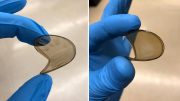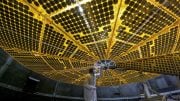
Researchers from FAU, the University of Rostock, and the University of Konstanz have precisely controlled electron emission from metals by superimposing two laser fields of different strengths and frequencies. This groundbreaking discovery could lead to new quantum mechanical insights and enable electronic circuits that are a million times faster than current technology.
Physicists measure and control electron release from metals in the attosecond range.
By superimposing two laser fields of different strengths and frequency, the electron emission of metals can be measured and controlled precisely to a few attoseconds. Physicists from Friedrich-Alexander-Universität Erlangen-Nürnberg (FAU), the University of Rostock and the University of Konstanz have shown that this is the case. The findings could lead to new quantum-mechanical insights and enable electronic circuits that are a million times faster than today.
Light is capable of releasing electrons from metal surfaces. This observation was already made in the first half of the 19th century by Alexandre Edmond Becquerel and later confirmed in various experiments, among others by Heinrich Hertz and Wilhelm Hallwachs. Since the photoelectric effect could not be reconciled with the light wave theory, Albert Einstein came to the conclusion that light must consist not only of waves, but also of particles. He laid the foundation for quantum mechanics.
Strong laser light allows electrons to tunnel
With the development of laser technology, research into the photoelectric effect has gained a new impetus. “Today, we can produce extremely strong and ultrashort laser pulses in a wide variety of spectral colors,” explains Prof. Dr. Peter Hommelhoff, Chair for Laser Physics at the Department of Physics at FAU. “This inspired us to capture and control the duration and intensity of the electron release of metals with greater accuracy.“ So far, scientists have only been able to determine laser-induced electron dynamics precisely in gases – with an accuracy of a few attoseconds. Quantum dynamics and emission time windows have not yet been measured on solids.
This is exactly what the researchers at FAU, the University of Rostock, and the University of Konstanz have now succeeded in doing for the first time. They used a special strategy for this: Instead of just a strong laser pulse, which emits the electrons a pointy tungsten tip, they also used a second weaker laser with twice the frequency. “In principle, you have to know that with very strong laser light, the individual photons are no longer responsible for the release of the electrons, but rather the electric field of the laser,” explains Dr. Philip Dienstbier, a research associate at Peter Hommelhoff’s chair and leading author of the study. “The electrons then tunnel through the metal interface into the vacuum.” By deliberately superimposing the two light waves, physicists can control the shape and strength of the laser field – and thus also the emission of the electrons.
Circuits a million times faster
In the experiment, the researchers were able to determine the duration of the electron flow to 30 attoseconds – thirty billionths of a billionth of a second. This ultra-precise limitation of the emission time window could advance basic and application-related research in equal measure. “The phase shift of the two laser pulses allows us to gain deeper insights into the tunnel process and the subsequent movement of the electron in the laser field,” says Philip Dienstbier. “This enables new quantum mechanical insights into both the emission from the solid state body and the light fields used.”
The most important field of application is light-field-driven electronics: With the proposed two-color method, the laser light can be modulated in such a way that an exactly defined sequence of electron pulses and thus of electrical signals could be generated. Dienstbier: “In the foreseeable future, it will be possible to integrate the components of our test setup – light sources, metal tip, electron detector – into a microchip.“ Complex circuits with bandwidths up to the petahertz range are then conceivable – that would be almost a million times faster than current electronics.
Reference: “Tracing attosecond electron emission from a nanometric metal tip” by Philip Dienstbier, Lennart Seiffert, Timo Paschen, Andreas Liehl, Alfred Leitenstorfer, Thomas Fennel and Peter Hommelhoff, 26 April 2023, Nature.
DOI: 10.1038/s41586-023-05839-6








It will be the normal state in particle physics research to manipulat microscopic particles by optical wave vortexes. Just as sunlight can manipulate the growth of plants. According to the gravitational field theory of topological vortex, only by playing with topological vortex can we truly become the master of the universe.